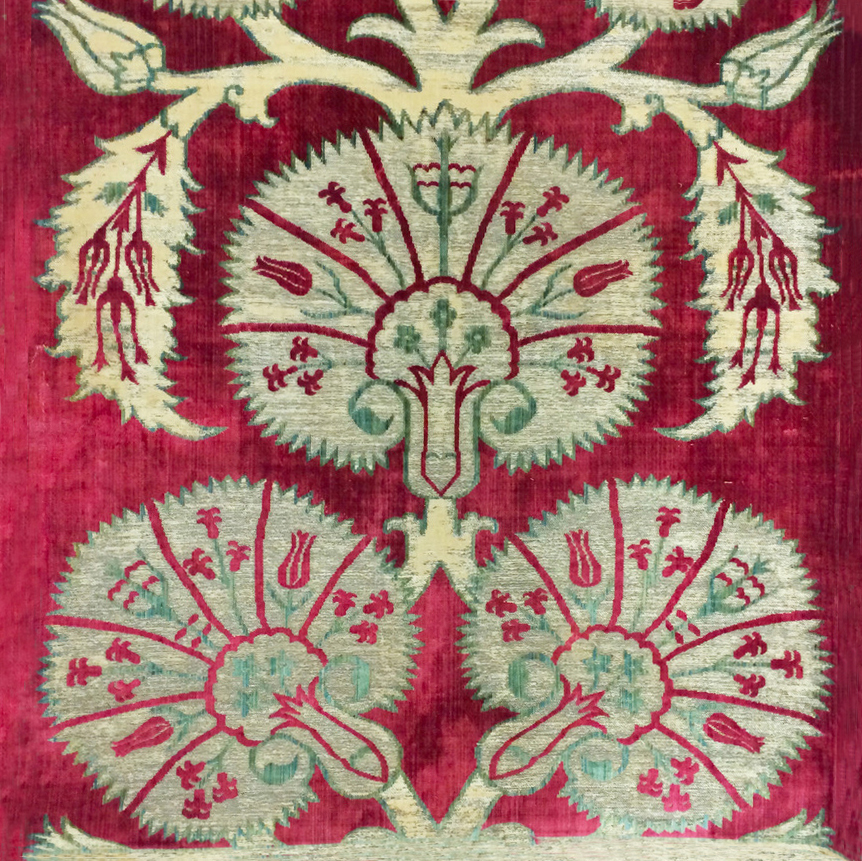
DOCTORAL STUDENT
ADVISOR
Professor Christophe Girot
PROJECT TIMEFRAME
Ongoing
*Seventeenth century Ottoman velvet brocade featuring fan-like carnations with a fill of tulips, roses, and hyacinths. Photographs: Lara Mehling, Courtesy of Museum of Fine Arts, Boston.
Turkey Red: Ottoman Textiles at the Root of the Parterre de Broderie
This dissertation project sets out to trace the transregional and transmaterial journey of the quatre fleurs, four of the most popular flowers featured in Ottoman decorative arts—the tulip, rose, carnation, and hyacinth—as they made their way from the wild desert landscapes of Central Asia to the ornamental flower parterres of European baroque gardens. The project presupposes that until the advent of a globalized textile industry in the nineteenth century, woven floral motifs still reflected not only local traditions in the arts and crafts but also a region’s botanical legacy. As such, parallel developments in horticulture and visual culture at the Ottoman court in the sixteenth century led to a new floral style, which reflected the empire’s unique geographic convergence of aesthetics and flora. Through an investigation into both the cultivation and woven representation of the tulip, rose, carnation, and hyacinth along this westward journey, the dissertation suggests that the parterre de broderie in Francehas its roots in Ottoman textiles.
Summary
At the height of their classical period, the Ottomans drew the regional landscape indoors; West Asian flora became the symbols of their most coveted silk textiles. By the mid-sixteenth century, they had synthesized a great stylistic and horticultural inheritance from across the arid Anatolian and Iranian Plateaus in the production of a new imperial identity. This unified cultural expression, epitomized by the quatre fleurs decorative style, marks a divergence from the Turco-Iranian “international Timurid” style, which had predominated in the region. That the Ottomans should choose wildflowers as their representatives at the peak of their political power is not surprising considering that Anatolia has long symbolized a botanical holy grail. Early on, the Ottoman court procured roses from Edirne, hyacinths from Maraş, and anemones from Manisa for year-round blooms in their private gardens. The quartet of red or pink tulips (lâleler), roses (güller), carnations (karanfiller), and hyacinths (sümbüller) gained unparalleled popularity—due in part, perhaps, to their shared crimson color.
In fact, when the Flemish herbalist Ogier Ghiselin de Busbecq (1522–1592) brought the beloved red tulip back from Anatolia for the botanist Carolus Clusius (1526–1609) at Leiden University, the allure of a rich red hue with no equivalent in Northern European gardens, drove European courts to send envoys to the Ottoman Empire in search not only of Busbecq’s famed “red lily” but also recipes for the reproduction of the uniquely long-lasting dye made from the root of the Rubia plant, which came to be known in Europe as ‘Turkey red.’ In this way, the brightly colored desert flowers made their way westward in pleasing indoor and outdoor spatial arrangements—on textiles, in vases and parterres. As such, the cultural aesthetics, climate, and technological know-how of the Ottoman capital on the edge of Islamic and Christian worlds, made it a ‘transformer’ between the artistic legacy of ancient Persia to the east and the burgeoning designs of France to the west.
This productive era of transfer is defined by a period that spans approximately one century, from the establishment of Kara Memi’s the new quatre fleurs decorative style at the Ottoman court around 1550 to the manifestation of a new garden style in France which seamlessly integrated the ornamental qualities of West Asian flora and the Renaissance arabesques: the parterres de broderie at Vaux-le-Vicomte designed by André Le Nôtre in 1656.

